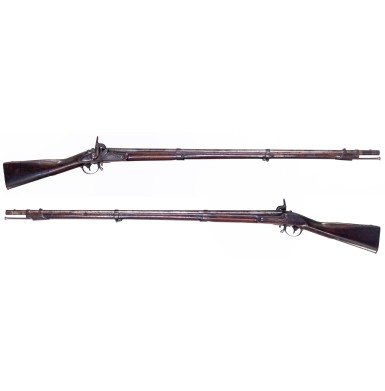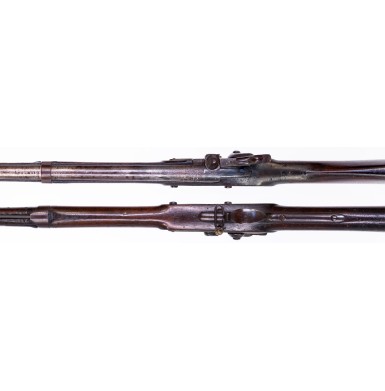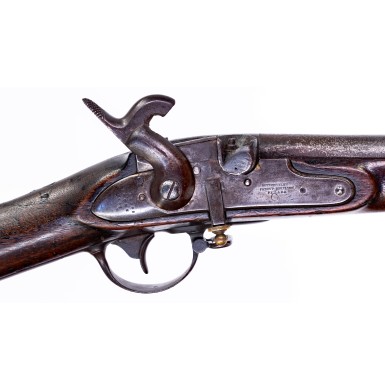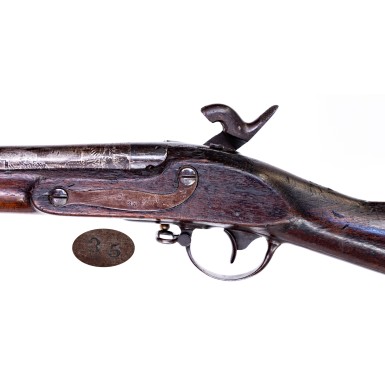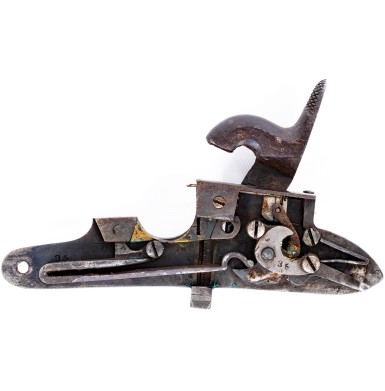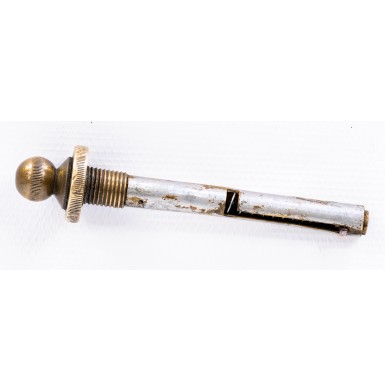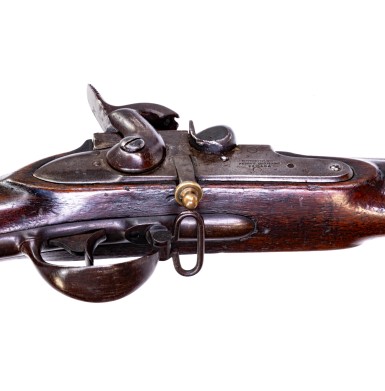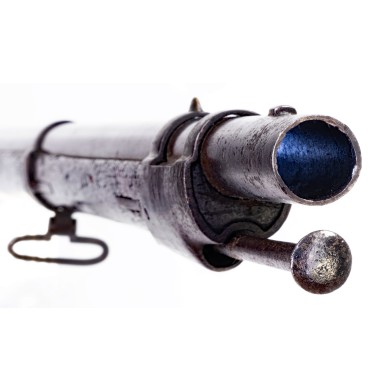Very Rare Butterfield Automatic Pellet Primer Conversion of a Harpers Ferry Musket
- Product Code: FLA-4018
- Availability: In Stock
-
$5,750.00
With the adoption of the US Model 1842 Musket, the US military officially embraced the percussion ignition system as standard for all small arms and as the ignition system to be used for the foreseeable future. While the percussion system had been introduced experimentally with Hall Patent Carbines circa 1833, it was the adoption of the US Model 1841 “Mississippi Rifle” circa 1841 and then the Model 1842 Musket, that cemented the system as the current standard. Almost immediately, the Ordnance Department began to consider the method best suited to alter the huge stocks of flintlock muskets in inventory to the new percussion system. Hundreds of thousands of older US Model 1816/22/28 pattern flintlock muskets were currently in stores around the country, and even worse, many newly made US Model 1835/40 flintlock muskets were still being delivered by contractors, even as the newly adopted Model 1842 percussion muskets were being produced at the national armories at Springfield and Harpers Ferry. In 1842, a group of Ordnance Department inspectors began the laborious task of inspecting and classifying the nearly one million flintlock rifles and muskets in storage around the country for the purposes of determining which were suitable for alteration to percussion and in what order the alterations should be accomplished. In 1844, an Ordnance Department board of officers was convened to consider the best method by which the percussion alterations should be performed, and it was at this time that the “Belgian” or “Cone in Barrel” alteration system was officially adopted. By early 1848, the necessary machinery had been produced, and the percussion alteration operations were underway at the national arsenals at Springfield and Harpers Ferry, as well as at four regional arsenals: Watertown, Allegheny, Watervliet and Washington.
Nearly simultaneously, with the constant pressure to “build a better mouse trap”, another Ordnance Department board was convened in February of 1845 to consider a newly invented automatic priming system. The system had been invented by dental surgeon and firearms innovator Dr. Edward Maynard. His Maynard Tape Priming System was an automated priming system that utilized a varnished strip of paper with small amounts of fulminate of mercury sandwiched between the two layers, similar to a modern-day child’s cap gun. The system advanced the roll of primers each time the hammer was cocked, and upon firing, a sharp lip on the hammer’s nose cut off the spent cap. Despite the fact that the ordnance board felt that Dr. Maynard’s design was experimental at best, in March of 1845 they paid him a $4,000 royalty for the right to adapt up to four thousand small arms to his system which was protected under US Patent #4,208, issued in 1845. These experimental weapons would include 200 Sharps Model 1851 carbines and 2,000 US Model 1840 flintlock muskets. Interestingly, the US Navy agreed to try out the system as well, paying Maynard an additional $1,000 to use his system on 1,000 US Jenks Naval Carbines that would be manufactured by Remington. The resulting musket alterations are the ones we know of today as the “Nippes-Maynard” alteration muskets. The mostly positive results of the experimentation with the system resulted in further trials, with the US government paying Maynard an additional $50,000 in 1854 and applying an improved version of his automatic priming lock to the alteration of some 20,000 flintlock muskets. These Remington-Maynard altered muskets performed well enough that the US government would subsequently pay Maynard an additional $75,000 for the use of his priming system on the US Model 1855 series of arms.
At about this same time Harpers Ferry experimented with a hammer mounted Maynard priming system altering at least 82 muskets to this experimental system. As none of these guns are known to survive today, it is not known if they were similar to the Ward’s Patent Hammer Mounted Tape Priming System. Lieutenant James Noble Ward’s system was patented in 1856. During fiscal year 1858 (July 1857-1858)100 muskets were altered to Ward’s system at the New York Arsenal. Like the Harpers Ferry hammer mounted system, none of these are known to survive either, although about 300 were altered by Ward’s system for the State of New York circa 1857-1858.
The primary competitor to the Maynard automatic priming system that was based upon a tape feed system was the pellet primer system. Christian Sharps had initially patented his pellet priming system in 1852, and R.S. Lawrence subsequently improved the system and with the introduction of the 1852 series of Sharps longarms, Sharps started to incorporate his pellet priming system, instead of the Maynard system that he had utilized on earlier models. It is likely that the Sharps/Lawrence pellet system was the inspiration for Jesse Butterfield’s experimentation with the concept and his eventual patenting of a new pellet priming design.
Jesse Butterfield of Philadelphia, PA received his initial self-priming lock patent on January 2, 1855, with an additional patent that covered improvements to the system on December 11, 1855. These improvements centered around applying the system to the alteration of flintlock muskets to percussion. Like the Sharps’ system, Butterfield’s used disc shaped “pellet” primers, which were loaded into a brass magazine tube. However, the Butterfield magazine tube was part of the priming system rather than simply a method of carrying the pellets and loading them into the primer mechanism as it was with the Sharps design. Butterfield’s spring-loaded tube exerted constant upward pressure on the pellets. The mechanical priming mechanism involved a flat metal arm with a hole in the front center of it, which moved with the cocking and releasing of the gun’s hammer. When the hammer was cocked, the arm was withdrawn into the mechanism, placing the hole over the magazine tube. When the hammer was released by pulling the trigger, the arm extended as the hammer fell, placing the hole with the primer pellet over the percussion cone as the hammer hit it. By early Spring of 1858, Butterfield’s system had attracted the attention of the US Ordnance Department, and they decided to test it. The initial testing was a disaster as the priming mechanism was not correctly attached to the musket lock. After solving the problem, the mechanism was tested again and this time the results were favorable. The subsequent testing was held on March 18, 1858, with a properly constructed lock and primer mechanism produced more promising results. As a result, Major of Ordnance William H Bell recommended further testing. On April 1, 1858, Bell issued a report that read in part:
“On the whole, the superiority of Butterfield’s apparatus over the Maynard primer working from the lock plate of the new musket appears from the above experience to be clearly established. The principal advantage being in accuracy and uniformity in the feeding out of the primer, in which respect, this application of Maynards without cog wheel appears to be deficient.”
As a result of the positive review, the Ordnance Department entered into an arrangement with Jesse Butterfield, which would allow the Ordnance Department to “apply” Butterfield’s mechanism to 5,000 (some sources note 3,000) muskets. The Ordnance Department paid Butterfield $3,000 for these rights, but did not contract with him to do any work. Apparently, the modifications were never pursued by the Ordnance Department, but Butterfield kept experimenting. In April of 1860 Butterfield was issued two flintlock rifles from the Frankford Arsenal to use in furthering his work on mechanical primer alterations. With the outbreak of the Civil War, Butterfield entered into an arrangement with the state of Pennsylvania to alter 1,000 state owned flintlock muskets to his self-priming mechanism and add sights for the price of $4.00 per musket. The work was to be done by The Keystone Rifle & Revolver Works - Butterfield & Company. The company had been formed by Butterfield and William B. Mann in April of 1861 for the specific purpose of altering muskets to his automated priming system and for the production of his .41 caliber “Army” pattern revolvers that also utilized the Butterfield automatic priming system. Butterfield performed the alterations by cutting off the barrels and installing a chambered breech, along with a lock modified with his automatic priming system. The guns were rifled with three broad, shallow grooves with a rate of twist of 1:72”. It does not appear that Butterfield installed any sights on these guns, but he did increase the height of the bayonet lug to engage the locking ring on specially modified US M1816/22/28 socket bayonets. According to arms researcher and author George Moller, Butterfield delivered 100 of the altered muskets to the state of Pennsylvania on September 2, 1861, and another hundred were delivered on November 6, 1861. Moller notes that “All but one of the known surviving examples of the 200 Butterfield-altered muskets are Model 1816 (Type II) and (Type III) muskets.”
Two distinct styles of automated primer locks are noted on the handful of surviving examples of Butterfield’s alterations. One has the priming system mounted on the outside of the lock plate and the other has the system recessed into the lock plate. It is not clear which variant is the “first” delivery style and which is the “second” delivery style. In either case, the lots of 100 muskets were assembly marked with a number from 1-100 during the alteration process. After the delivery of the 200 mechanically primed arms, Butterfield renegotiated his contact to make subsequent deliveries of muskets with chambered breeches, altered to percussion, but without the automated priming system. Records indicate that Butterfield delivered 1,010 of these conventionally altered percussion muskets to the state of Pennsylvania by the end of January 1862. During this time, he also repaired or refurbished 82 “U.S. Rifles”. These were most likely US Model 1841 Rifles, but could have been US Model 1855 Rifles, or even a mixture of both. He also altered some flintlock rifles to percussion, likely US Model 1817 Rifles that were in Pennsylvania state arsenals. Today it remains unclear to which Pennsylvania regiments the Butterfield automated priming muskets were issued, if they were issued at all.
Today, Jesse Butterfield is most often remembered for the percussion revolver of his design, which featured the same unique automatic priming system as utilized on this musket. The Butterfield “Army” revolver was produced in .41 caliber from 1861-62, with an estimated production of only 640, making it an incredibly scarce and desirable secondary martial revolver of the Civil War era. However, Butterfield’s altered muskets are much scarcer, with late arms historian and author Howard Michael Madaus suggesting that significantly less than 50 of these arms survive today.
This Very Rare Butterfield Automatic Priming Alteration Musket (Flayderman 9A-266) is in about GOOD condition overall. This example is one with an “interior” mounted priming system, where it is recessed into the lockplate and is built on a Harpers Ferry US Model 1828 (1816 Type III) Musket. The Butterfield modified lock is marked in three horizontal lines, forward of the hammer and priming mechanism:
BUTTERFIELD’S
PATENT Dec 11, 1855
PHILADA
The markings remain clear and fully legible. The tail of the lock is marked in three vertical lines:
HARPERS
FERRY
1841
Amazingly, the Butterfield lock mechanism is fully functional and works exactly as it should. The feeder arm is fully functional and is not broken or damaged in any way. The original magazine feeder tube is in place and is complete, correct and functional. An interesting safety feature of the lock’s design is that the tube can only be unscrewed and removed from the lock when it is in the half cock position. When at full cock or in the fired position, the primer tube cannot be removed from the lock. The original central “firing pin” is present, inside the face of the hammer, surrounded by the skirt. This narrow projection was intended to strike the pellet primer and push it through the feed arm hole and detonate it against the percussion cone (nipple). This is similar to the extended hammer nose used on the Butterfield revolvers. In both cases the goal was to avoid damaging the feed arm by punching through the feed arm’s pellet hole.
As noted on all extant Butterfield primer altered muskets, the gun exhibits a reassembly matching number on many of the components. In this case, the number is 35. The number appears inside the lockplate, on the bridle in the lock, on the S-shaped side plate, on the bottom of the chambered breech piece, and on the lower barrel band. The original Harpers Ferry assembly mark 0 appears on many of the parts as well. An indistinct rack number is stamped on the comb of the stock, which appears to be the number 54.
The gun has a moderately oxidized and mottled brown and gray patina with moderate pitting around the breech and bolster area and some evenly scattered light pitting over much of the metal with scattered impact marks as well. There are also some old vice marks around the patent breech area and rear portion of the barrel. The iron furniture has a more even brown patina that almost has the appearance of an old, browned finish, but is simply oxidation due to age. The barrel remains full length, measuring 42” to the end of the chambered breech. The bore is in about GOOD condition and has a heavily oxidized dark patina with scattered light to moderate pitting along its length. The bore only retains hints of the three-groove rifling, primarily closer to the breech with the muzzle area smoothbore. The musket retains both of the original sling swivels, mounted on the front bow of the triggerguard and on a lug under the middle barrel band. An original button head rammer is present in the channel under the barrel. It has not been recessed for use with conical projectiles in a rifled musket and may be an old replacement. The rod shows light pitting over much of its entire length, is full length and retains good threads at its end. The stock rates about GOOD overall, with one major restorative repair. The section of wood from the rear of the breech to the beginning of the comb has broken and been repaired, with the crack circling the top edge of the wrist, running from the rear lock mounting screw around the wrist just below the comb and around to the lock mortise behind the top rear part of the primer mechanism. This repair is well done and extremely stable and was not done in a way so as to try to conceal it or to deceive. Instead, two pegs have been inserted from the top, one behind the tang and one just forward of the comb, to reinforce and strengthen the repair. The crack actually blends very well and is difficult to see and were it not for the reinforcement pegs, the damage and repair might be missed during a casual inspection. The other wood “damage” is some moderate wear behind the rear barrel band where it apparently spent many years turned around backwards, leaving an area of wear the size and shape of the leading edge of the band. There is also an old sliver of wood, about 2” long, missing along the upper edge of the forarm on the reverse, between the middle and upper barrel bands. This is very old wood loss and has worn quite smooth over time. Additionally, the stock shows numerous bumps, dings, marks and mars from handling and use over the years.
Overall, this is a solid and authentic example of one of the least often encountered mechanically primed US military musket alterations. Even Flayderman, who rarely comments editorially about rarity in his descriptions notes that “The gun is a collector’s rarity.” I have personally only ever seen a handful of these very scarce guns for sale, and I am excited to be bringing one to the market. Although the gun is well worn and certainly saw some serious use and service, it is also an authentic example of a very scarce musket. This is a rare opportunity to purchase a very uncommon US conversion musket rarely comes up for sale. If you like to collect and display rare, odd and interesting US military arms, I can think of very few guns that will fill all of those categories as well as this one does. You may not have a chance to obtain one of these guns again for some time.
Tags: Very, Rare, Butterfield, Automatic, Pellet, Primer, Conversion, of, a, Harpers, Ferry, Musket


